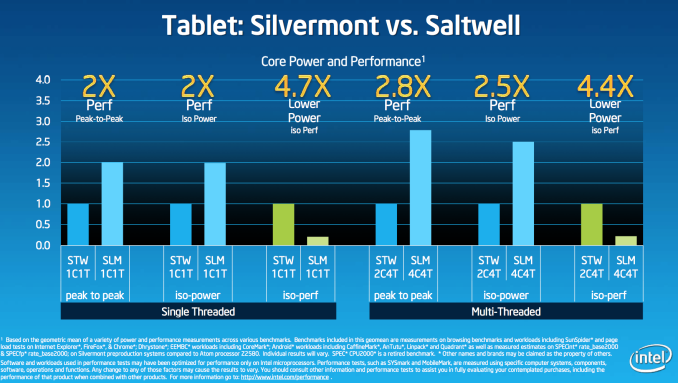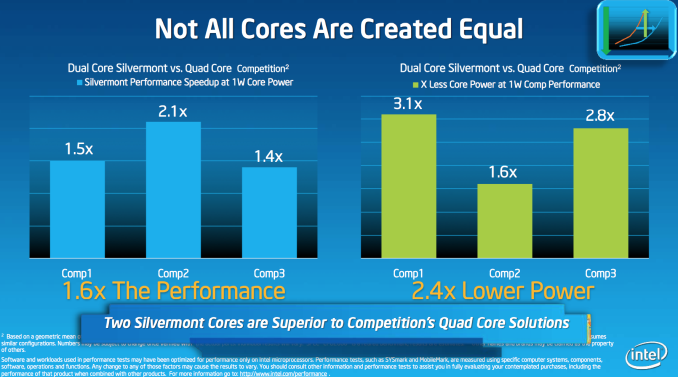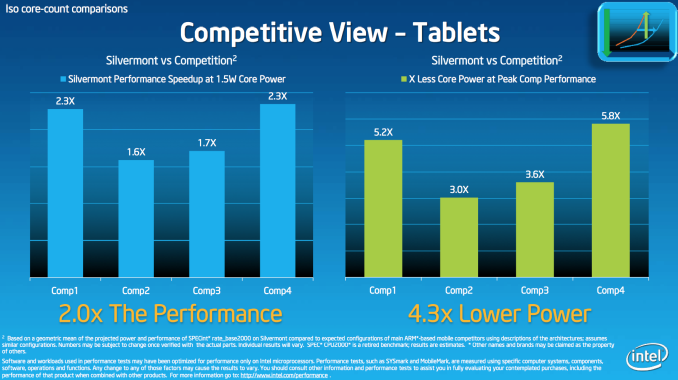Intel’s Silvermont Architecture Revealed: Getting Serious About Mobile
by Anand Lal Shimpi on May 6, 2013 1:00 PM EST- Posted in
- CPUs
- Intel
- Silvermont
- SoCs
Tablet Expectations
Intel is getting architectural details about Silvermont launch ahead of actual SoCs based on the CPU. Baytrail tablets based on Silvermont cores are currently in development and are expected to show up by the end of the year. The Silvermont story at the end of this year should be a lot better than Clovertrail last year. Windows 8 will be in its second major revision (codename Windows Blue) and Intel will launch with both Android and Windows tablet availability. The inclusion of Android is very important to hitting lower price points, something Clovertrail really didn’t have last year. We should see Baytrail based tablets span the gamut of Nexus 7 to iPad pricing, with Haswell picking up where Silvermont ends.
Form factors should be no thicker than Clovertrail based designs, although it will be possible to go thinner with Baytrail/Silvermont should an OEM decide to. Displays should also be a lot better this time around. Intel is working with some OEMs on color calibration, an important step forward as I’m hearing Qualcomm will be doing the same with Snapdragon 800. We’ll also finally see resolutions higher than 1366x768, including potentially some competition for the iPad with Retina Display. Silvermont’s new system agent should do a good job of prioritizing GPU access to main memory in these ultra high resolution scenarios.
Performance
With tablets still months away from being production ready, there’s nothing for us to publicly test. Intel did share some of its own numbers off of its Baytrail reference tablet however, and they are impressive.
All of the Intel comparisons report the geometric mean performance advantage over a spectrum of benchmarks. The benchmarks used include SPECint2K, CoreMark, SunSpider, web page load tests in IE/Chrome/Firefox, Linpack, AnTuTu and Quadrant (ugh) among others. The point here isn’t to demonstrate absolute peak performance in one benchmark, but to instead give us a general idea of the sorts of gains we should expect to see from Silvermont/Baytrail tablets vs the competition. It’s an admirable effort and honestly the right way to do things (short of actually giving us a pre-production tablet to test that is). We’ll start with a comparison to Saltwell, the previous-generation 32nm Atom core. The Saltwell results are listed as STW while Silvermont is abbreviated SLM:
In terms of absolute performance, Silvermont’s peak single threaded performance is 2x that of Saltwell. This 2x gain includes IPC and clock frequency gains (only 50% is from IPC, the rest is due to IDI, system agent and frequency). Given that Saltwell is competitive with existing architectures from ARM and Qualcomm (except for the Cortex A15), a 2x increase in single threaded performance should put Silvermont in a leadership position when it arrives later this year.
The next set of bars is just as important. At the same power levels (Intel didn’t disclose specifically at what power), Silvermont delivers 2x the performance of Saltwell. Finally, at the same performance level, Silvermont uses 4.7x lower power. Given that Saltwell wasn’t terrible on power to begin with, this is very impressive. Without knowing the specific power and performance levels however, I wouldn’t draw too many conclusions based on this data though.
The multithreaded advantages are obviously even greater as Silvermont will be featured in quad-core configurations while Saltwell topped out at dual-core (4 threads) in tablets.
In the next two slides, Intel did some competitive analysis with Silvermont vs. the ARM based competition. The benchmarks are the same, but now we have specifics about power usage. In the first test Intel is comparing to three competitors all with quad-core designs. Intel claims to have estimated performance gains based on what is expected to be in the market by the end of this year. Intel’s performance modeling group is very good at what it does, but as with any estimate you always have to exercise some caution in buying the data until we have physical hardware in hand.
Intel isn’t naming the three competitors in this chart, but there are only a finite number of quad-core ARM players shipping in decent tablet designs these days. The chart on the left compares performance of a dual-core Silvermont to quad-core ARM based designs at a 1W core power level. This comparison is extremely important because it’s effectively demonstrating the type of advantage Intel hopes to have in smartphones next year.
The chart on the right fixes performance and shows the reduction in core power. Do keep in mind that there can be a big difference between core and device level power, although Intel does expect to be very competitive on battery life this round.
The final performance comparison slide increases max core power to 1.5W and compares quad-core Silvermont to the quad-core competition. You’ll note the arrival of a new competitor here. One of the bars is a dual-core SoC with its performance scaled to four cores. I’m less confident about that particular estimation simply because it assumes Apple won’t significantly update architectures in its next generation of iPads.
The performance deltas here are huge. If we assume that at least one of these bars represents a Cortex A15 based design, Silvermont looks very good.
That’s the end of the Intel data, but I have some thoughts to add. First of all, based on what I’ve seen and heard from third parties working on Baytrail designs - the performance claims of being 2x the speed of Clovertrail are valid. Compared to the two Cortex A15 designs I’ve tested (Exynos 5250, dual-core A15 @ 1.7GHz and Exynos 5410 quad-core A15 @ 1.6GHz), quad-core Silvermont also comes out way ahead. Intel’s claims of a 60% performance advantage, at minimum, compared to the quad-core competition seems spot on based on the numbers I’ve seen. Power is the only area that I can’t validate based on what I’ve seen already (no one has given me a Baytrail tablet to measure power on). Given what we know about Silvermont’s architecture and the gains offered by Intel’s 22nm process, I do expect this core to do better on power than what we’ve seen thus far from ARM’s Cortex A15.
There is something we aren’t taking into account though. As of now, the only Cortex A15 based SoCs that we’ve seen have been very leaky designs optimized for high frequency. Should an SoC vendor choose to optimize for power consumption instead, we could see a narrower gap between the power consumption of Cortex A15 and Silvermont. Obviously you give up performance when you do that, so it may not ultimately change anything - but the power story might be less of a blowout.













174 Comments
View All Comments
tech4real - Tuesday, May 7, 2013 - link
"Absolute performance"? Do we consider power constraint here at all? Atom is optimized for power-efficiency. All the current information I've seen so far suggest Silvermont will outperform A15 by a large margin in terms of power efficiency. If we throw away power constraint, Intel has Core to take care of that.Wilco1 - Tuesday, May 7, 2013 - link
I was talking about peak performance, but yes, power consumption matters too. What we've seen so far is Intel marketing suggesting that in 6-9 months time Silvermont will be more efficient than A15 was 12 months earlier. However that's not what Silvermont will have to compete with. At the end of this year A15 will have had 2 process shrinks down to 20nm in addition to a lot of tuning, so it will be far more efficient than it was 12 months ago. And A15 is just one example, Apple, QC and ARM will have new cores as well. It's reasonable to say that Intel will finally be able to compete with Silvermont, but it is far from clear that it is the overall winner like their marketing claims.tech4real - Wednesday, May 8, 2013 - link
TSMC's 20nm process is still in the works, your Q4'13 volumn production estimate seems way too optimistic, especially considering TSMC's pain in 28nm ramp. Also 28nm->20nm shrink without finfet significantly reduces its benefit.Wilco1 - Wednesday, May 8, 2013 - link
TSMC have learnt from the 28nm problems. They appear very aggressive this time, and so far the reports are they are 2 months ahead of schedule. Even if it ends up delayed to Q2'14 it's still around the same time Intel is planning to come out with Silvermont phones. The gains are not as large as with FinFETs, but enough to reduce power significantly.tech4real - Wednesday, May 8, 2013 - link
my understanding is Q2'14 volume production with high yield is almost TSMC 20nm best case scenario. Of course, the term "high yield" is such a subjective thing vendors love to manipulate with almost infinite freedom...zeo - Wednesday, May 8, 2013 - link
TSMC 20nm isn't set up for such optimization, but rather focused on cost reductions... The number of nodes, variations supported, etc will be fewer than they did with 28nm as they want to avoid the problems that caused the 28nm delays and that has resulted in a much more streamlined setup.While power leakage issues increase as FAB size is decreased... So without a solution like FinFET the power efficiency would be increasingly harder to keep it where it is, let alone reduce it...
It's one of the reasons why ARM is trying to push other options like Big.LITTLE to boost operational efficiencies and not rely as much on FAB improvements.
While it's also why not all ARM SoCs have moved to 28nm yet as for many the power leakage was still too much of a issue for their designs to make the switch right away, so there could be additional delays for 20nm releases.
Though ARM should get FinFET in time for for the 64bit release... but by that time Intel would be on its way to 14nm...
Jaybus - Wednesday, May 8, 2013 - link
Think of it as 2-wide x86 vs. 3-wide RISC. Rather than translating the x86 microcoded instruction into 2 or 3 RISC-like instructions, Intel's decode keeps it a single instruction down the pipeline. The RSIC architecture has to decode more instructions, so needs the 3-wide to keep up with the x86 2-wide.The point about the frequency scaling is this. The tri-gate design has a gate on top of 2 vertical gates. This gives it 3x the surface area as compared to FinFET. The greater surface area allows more electrons to flow within a given area of the die, and that allows a greater range of voltages and/or frequencies for which it can operate efficiently.
Wilco1 - Thursday, May 9, 2013 - link
Eventhough macro-ops helps decode, they need to be expanded before they are executed. So in terms of execution, macro-ops don't help. Also as I mentioned in an earlier post, most ARMs also support macro-ops, allowing a 2-way ARM to behave like a 4-way. So macro-ops don't give x86 an advantage over RISC.jemima puddle-duck - Monday, May 6, 2013 - link
Without wishing to be overly cynical, Anandtech has a history of 'NOW Intel will win the mobile war' articles, which get recycled then forgotten in time for the next launch. It's all very clever stuff, but curiously underwhelming also.Roffles12 - Monday, May 6, 2013 - link
I don't remember reading any 'NOW Intel will win the mobile war' articles on Anandtech. Perhaps your perception is skewed. Intel articles are typically of a technical nature discussing the inner workings of the architecture and fab process or discussing benchmarks. Intel is really the only company so completely open about how their technology works, so why not make it a point of discussion on a website on a website dedicated to the subject? If your head is clouded by fud from competing companies and the constantly humming rumor mill, maybe you need to back off for a while. At the end of the day, it's up to you to digest this information and form an opinion.